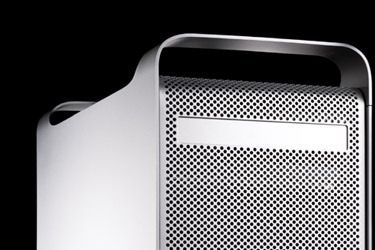
|

|
| When we set out to radically
redesign the Power Mac product line, we decided to create the world’s coolest
personal computer in every sense of the term. That meant using not just fans,
but also enlisting important airflow principles to reach that objective. To that end, the Power Mac G5’s anodized aluminum alloy enclosure is designed around four independently controlled thermal zones for intelligently channeled airflow. To make the Power Mac G5 even cooler, a see-through internal air deflector channels airflow over the processor heat sinks and the expansion slots. 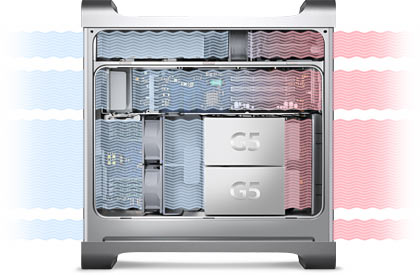
It’s no secret that computers generate heat. So Apple divided the inside of the Power Mac G5 into four discrete thermal zones, compartmentalizing the primary heat-producing components — processor, PCI, storage and power supply. This allows the system to increase or decrease the temperature of a single zone without affecting the others. 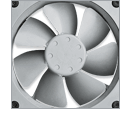 Each of the four thermal zones is equipped with its own dedicated, low-speed
fans. Apple engineered seven of the nine fans to spin at very low speeds
for minimum acoustic output. And Mac OS X constantly monitors component temperatures
in each zone, dynamically adjusting individual fan speeds to the appropriate
levels for the quietest possible operation. As a result, the Power Mac G5
runs three times quieter than the previous Power Mac G4 enclosure.
Each of the four thermal zones is equipped with its own dedicated, low-speed
fans. Apple engineered seven of the nine fans to spin at very low speeds
for minimum acoustic output. And Mac OS X constantly monitors component temperatures
in each zone, dynamically adjusting individual fan speeds to the appropriate
levels for the quietest possible operation. As a result, the Power Mac G5
runs three times quieter than the previous Power Mac G4 enclosure.We were also pretty obsessive about clutter. That’s why there isn’t any. Especially conspicuous by its absence is that tangle of unsightly wires and cables that turn the inside of a typical PC into a veritable rat’s nest. That’s because “a place for everything and everything in its place” isn’t just something your mom said: It’s an important philosophical precept that Apple applies rigorously to hardware design. And it’s why this new enclosure represents such an incredible feat of engineering. 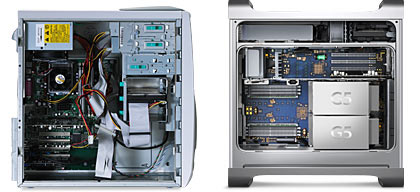
The PC on the left shows that if you try hard enough you might cram everything into the average PC case. The Power Mac G5 was designed from the inside out so that the case and internal components were meant to go together. A exceptional computer demands an exceptional enclosure. The Power Mac G5 has a stunning new chassis constructed of anodized aluminum. Because let’s face it, however beautiful you may be on the inside, it helps to be a looker on the outside, too. Thanks to attention to detail, the G5 enclosure also features an easy-to-open access panel with remarkably quick access to internal components for tool-free installation of memory, hard drives, optical drives or an AirPort Extreme card. And with front-mounted FireWire, USB, headphone ports and handles, the Power Mac G5’s enclosure is designed for your convenience. |
Shhhhhhhhhhhhh. Be quiet. The front and rear panels are perforated for optimal airflow. The way
it works is, cooler outside air enters the enclosure, flows over the heat-producing
components, and exhausts out the perforations in the rear panel.
The front and rear panels are perforated for optimal airflow. The way
it works is, cooler outside air enters the enclosure, flows over the heat-producing
components, and exhausts out the perforations in the rear panel. |
 Access is everything
Access is everythingThat’s why the Power Mac G5’s easy-to-open side panel unlatches in a snap, giving you fast access to the slots and bays inside. Designed for no-hassle expansion, the Power Mac G5 lets you add things like memory or an AirPort Extreme card without tools. And easy-to-use drive guides let you mount high-capacity hard drives as soon as your requirements grow. Additionally, a locking mechanism on the side door prevents unauthorized access, keeping the inside of your computer safe from tampering. |
|
 Plugged in
Plugged inIt’s easy to plug printers, scanners and other devices into the Power Mac G5. In addition to sporting a full complement of ports on the back, the front panel has FireWire 400 and USB 2.0 ports, as well as a headphone jack. |
|
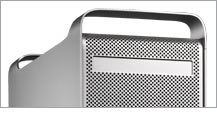
Get a handle on it The Power Mac G5’s built-in handles will come in handy the day you need to move all your stuff into that corner office you’ve always had your eye on. |
| . | . | . |
| -- |
PowerMac G5
|
Juli. |
|
64-bit breakthrough
|
2003
|